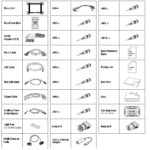Understanding your car’s health is crucial, and the On-Board Diagnostics II (OBD2) system is a vital tool in this process. When your vehicle detects an issue, it generates a Diagnostic Trouble Code (DTC), also known as an OBD2 fault code. These codes are standardized across the automotive industry, ensuring that mechanics and car owners alike can understand and address vehicle problems effectively. This article provides an overview of standard OBD2 fault codes, helping you navigate the world of automotive diagnostics.
What are Standard OBD2 Fault Codes?
Standard OBD2 fault codes, often referred to as generic codes, are a universal language for vehicle diagnostics. These codes are recognized by all vehicle manufacturers and can be accessed using any standard OBD2 scanner. The standardization ensures compatibility and simplifies the diagnostic process, regardless of the car brand. These codes are critical for identifying issues related to the powertrain, chassis, body, and network systems of your vehicle.
This image displays an example of a standard OBD2 fault code, P0301, illustrating the structure and components of these diagnostic codes.
Decoding the Structure of OBD2 Codes
OBD2 fault codes follow a specific format that provides valuable information about the issue. Let’s break down the structure:
-
First Letter (Family): This letter indicates the system where the fault originated:
- P (Powertrain): Relates to the engine and transmission.
- C (Chassis): Concerns systems like braking, steering, and suspension.
- B (Body): Involves components like airbags, power windows, and central locking.
- U (User Network): Indicates issues with the vehicle’s communication network.
-
First Digit (Code Type): This digit specifies whether the code is generic or manufacturer-specific:
- 0: Generic OBD2 fault code (standard across all manufacturers).
- 1: Manufacturer-specific fault code (unique to a particular car brand).
-
Last Three Digits (Fault Number): These digits are hexadecimal numbers that pinpoint the specific problem. For ‘P’ codes, the second digit further defines the sub-system:
- P00xx, P01xx, P02xx: Fuel and air metering issues.
- P03xx: Ignition system or misfire problems.
- P04xx: Auxiliary emission controls.
- P05xx: Idle control system.
- P06xx: Onboard computer and output systems.
- P07xx, P08xx, P09xx: Transmission issues.
- P0Axx, P0Bxx, P0Cxx: Hybrid propulsion systems.
These standardized codes are based on SAE J2012 and ISO 15031-6 standards, encompassing a vast library of approximately 11,000 definitions in their latest versions.
Accessing Comprehensive OBD2 Fault Code Lists
While understanding the structure is helpful, having access to a complete List Of Obd2 Fault Codes is essential for accurate diagnosis. We offer resources to help you delve deeper into specific code ranges:
- DTC from P0000 to P0299
- DTC from P0300 to P0399
- DTC from P0400 to P0499
- DTC from P0500 to P0599
- DTC from P0600 to P0699
- DTC from P0700 to P0999
- Full list of codes
For a more in-depth diagnostic experience, consider using our free EOBD-Facile car diagnostic software, compatible with ELM327 and ELM323 interfaces. This software provides access to all 11,000+ codes, making vehicle diagnostics more accessible than ever.
By understanding the structure and accessing comprehensive list of obd2 fault codes, you are better equipped to diagnose and address car issues, ensuring your vehicle runs smoothly and efficiently.
